Matador Network's Blog, page 510
March 1, 2022
The 9 best Michelin-starred restaurants in small towns

The Michelin star is the gold standard of the restaurant industry. It tells you that the restaurant breathes rarified air, reserved for the most top-tear eateries in the world. It’s not unreasonable to assume that most Michelin-starred restaurants are located in major cities. After all, that’s where chefs experiment with creative cuisines, thriving in places that tend to pride themselves on an eclectic and diverse the restaurant scenes. Big cities are the prime time stage, where travelers expect elegant and well thought out dishes that typically break with tradition when it comes to ingredients and preparation. This is how world-class chefs go to showcase their talents. But you don’t always have to navigate the big city streets, or endure a complex subway system, to reach a Michelin-starred restaurant. Perhaps contrary to popular belief, towns with a population as small as 100 are home to Michelin-starred restaurants, and the food is just as good as anything you’d find on Fifth Avenue. These are the best Michelin-starred restaurants in small towns.
The Inn at Little Washington, Washington VAView this post on Instagram
A post shared by The Inn at Little Washington (@innatlittlewash)
It’s one thing to find a Michelin-starred restaurant outside the bustle of a major metropolis, but how about a town of just 100 people? The Inn at Little Washington is a three-star Michelin restaurant in Washington, Virginia – a small town at the foot of the Blue Ridge Mountains. The inn’s restaurant is the creation of self-taught chef Patrick O’Connell, who specializes in American farm-to-table cooking fused with French technique. Much of the produce used in the restaurant is grown on a small onsite farm or sourced from local farmers, and the restaurant itself evokes the feeling of a romantic, countryside dinner party.
Tasting menu prices unavailable
Manresa, Los Gatos CAView this post on Instagram
A post shared by Manresa (@manresarestaurant)
Focusing on veggie-based cuisine, Manresa embraces the local flavor of California. The restaurant is known for its unconventional pairings and fusion of modern and traditional cooking, incorporating produce sourced from the region. Manresa partners with local Love Apple Farms to source nearly all its produce, and aims to evoke the spirit of the Bay Area in its cuisine. The Tidal Pool – a rich broth with mussels, oyster, shiitake mushrooms, and toasted nori – is particularly popular.
Tasting menu: $325 per guest
SingleThread, Healdsburg CAView this post on Instagram
A post shared by SingleThread (@singlethreadfarms)
SingleThread is more than just a typical restaurant. There’s an inn upstairs, a farm, and an impressive 11-course tasting menu that, taken together, evoke an immersive experience. The restaurant’s Japanese-inspired cuisine is the innovative result of chef Kyle Connaughton experience working in famed restaurants around the world. Located right in downtown Healdsburg, a town of just under 12,000, the restaurant also partners with local nonprofit Sonoma Family Meal to provide for those in need.
Tasting menu prices unavailable
Osteria Francescana, Modena ItalyView this post on Instagram
A post shared by Manfredintavola (@manfredintavola)
It shouldn’t take much convincing to visit Modena, Italy. Even without its Michelin-starred laurels, the medieval town is a picturesque and historic day-trip just an hour from Bologna, and worth visiting even if you don’t have your sights set on a culinary experience. But it’d be a shame to visit and not check out Osteria Francescana, located right in the medieval town center. When he opened the restaurant in 1995, chef Massimo Bottura strove to blend culinary innovation with contemporary design. True to his vision, the restaurant is now known for its experimental dishes inspired by traditional Italian cuisine, and the space is decorated with modern art.
12-course tasting menu: $326 per person
St Hubertus, San Cassiano ItalyView this post on Instagram
A post shared by St. Hubertus Restaurant (@st.hubertus_restaurant)
Italy is known for serving up good food nearly everywhere, not just at restaurants with accolades. But South Tyrol is doing most of the legwork. The region of northern Italy has a total of 23 Michelin stars across 20 different restaurants, which is the most of any region in the country. The St. Hubertus restaurant in Hotel Rosa Alpina is known for its mix of classic Italian flavors and “precise, technical know-how” (according to the Michelin guide). Only local ingredients found in the Dolomite mountains are used in the dishes here, so St. Huburtus is literally the best way to capture the region’s flavor.
Tasting menu: $362 per person
Bastide de Capelongue in Bonnieux, FranceLocated among the lavender fields near the village of Bonnieux in southern France, Bastide de Capelongue is housed in a stone farmhouse, along with a hotel. The restaurant offers six different tasting menus with dishes infused with the flavors of Provence, featuring ingredients grown in Chef Loubet’s own vegetable and herb garden. Stunning views are also on the menu here, as you’ll be able to see the Upper Provence Alps from the restaurant’s terrace.
Average tasting menu price: $120 per person
Restaurant Bareiss, Baiersbronn GermanyView this post on Instagram
A post shared by Stefan Leitner (@_stefan.leitner_)
The small town of Baiersbronn might not look like a hub of Michelin-starred restaurants, but the community of 15,000 people on the edge of the Black Forest is actually home to three Michelin starred restaurants – the highest density of Michelin stars in Germany. Restaurant Bareiss is one of the town’s three-star restaurants, helmed by Chef Claus-Peter Lumpp. Located on the property of the Hotel Bareiss, the restaurant has its own vegetable garden and breeds its own trout and deer. The luncheon menu is particularly popular, with six inventive courses consisting of Japanese-inspired tuna, a quiche, full fish and chicken courses, and small desserts.
Tasting menu prices unavailable
The Fat Duck, Bray UKView this post on Instagram
A post shared by The Heston Blumenthal Team (@thehestonblumenthalteam)
One of the UK’s most celebrated Michelin-starred restaurants, The Fat Duck is located in the unassuming town of Bray and housed in a 16th-century building. It’s known for being at the forefront of culinary innovations like food pairing and multi-sensory cooking, as well as its 14-course tasting menu with classics like nitro-scrambled egg, mock turtle soup, snail porridge, and crab ice cream. The restaurant is run by chef Heston Blumenthal, who has appeared on TV shows and is considered a culinary pioneer.
Tasting menu prices unavailable
Mirazur, Menton FranceView this post on Instagram
A post shared by Restaurant Mirazur (@restaurantmirazur)
You don’t have to go to Paris to experience France’s finest culinary creations. The town of Menton in the French Riviera might have under 30,000 people, but it also has one of the country’s most lauded restaurants. With views of the Mediterranean, Mirazur is set against a picturesque mountain backdrop and has its own terraced garden. Indeed, Chef Mauro Colagreco’s dishes are inspired by the restaurant’s scenic surroundings, with most ingredients grown in Mirazur’s private garden or sourced from the area.
Tasting menu: $430 per person 
Explore the world’s first UNESCO Trail for the ultimate trip through Scotland

Last year, Scotland launched the world’s first UNESCO Trail in a celebration of Scotland’s many UNESCO designations. The list of World Heritage Sites, geoparks, cities, and biospheres illustrate the diversity and beauty of the Scotland’s landscape and culture. A slow-travel trip along the trail is a cultural journey through key points in the region’s history — as well as a look into the lively culture of current day Scotland.
Planning a trip around some or all these sites is also in line with the country’s aspiration to be a world leader in responsible tourism. Encouraging visitors to adopt a slow travel approach to their vacation by taking time to truly experience the destination and make sustainable choices is one driving force behind this trip planning intuitive.
Scotland is an easy country to navigate, and you don’t have to plan a vacation around all of the UNESCO stops on the trail to enjoy the trail itself. With that said, we recommend taking your time to move slowly to truly appreciate the natural beauty of Scotland’s landscape, its rich and fascinating history, and the welcoming nature of the Scots.
Here are some of the highlights of Scotland’s UNESCO Trail.
1. Edinburgh, UNESCO City of Literature
Photo: Kenny Lam/VisitScotland
Edinburgh became the world’s first UNESCO City of Literature in 2004. The city’s culture is engrained with the contributions of many of its past and current residents, who have penned some of the world’s greatest masterpieces.
Perhaps it’s Edinburgh’s inspiring architecture or the rich art and academic accomplishments of those who call the city home that has contributed to creating such a creative atmosphere. You can walk in the footsteps of authors such as Sir Walter Scott, Robert Louis Stevenson, Robert Burns, JM Barrie, Muriel Spark, and JK Rowling.
You can learn about the lives of three of Scotland’s greats — Scott, Burns and Stevenson — at The Writers Museum which is free and located at the top of Edinburgh’s historic Royal Mile. In August, Edinburgh celebrates everything literature with Edinburgh International Book Festival. The festival celebrates international as well as Scottish writers, and attracts an audience of over 20,000, annually.
You can also visit the Scottish Storytelling Center year-round, which hosts one-off performances and regular storytelling readings. Check the center’s site for events. If you are traveling with young children they often have puppet shows and other wonderful Scottish cultural performances for a young audience.
2. Old and New Towns of Edinburgh, UNESCO World Heritage Site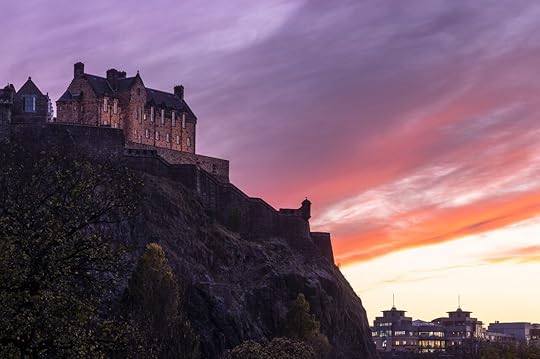
Photo: Kenny Lam/VisitScotland
Edinburgh has been the capital of Scotland for more than 500 years, and its topography and architecture are famous around the world. A city of two halves, Edinburgh has been an inspiration to European urban planning with the juxtaposition of the Old and New Towns — both of which have unique characteristics.
The medieval labyrinthine of closes and wynds of the Old Town are steeped with history, and New Town remains one of the best examples of Georgian town planning in Europe. The city is walkable and we recommend taking time to explore the streets of both sides of the city. Arthur’s Seat, a dormant volcano, sits 251 meters above sea level and gives you a superb view over the entirety of Edinburgh. You can walk to the summit of Arthur’s seat in a couple of hours from Hollyrood Park, adjacent to the Queen’s residence of Holyrood Palace.
3. The Forth Bridge, UNESCO World Heritage Site
Photo: Kenny Lam/VisitScotland
The Forth Bridge is a railway bridge that crosses the Forth estuary. At the time of construction, it was the world’s longest rail bridge, spanning 541 meters. It was awarded World Heritage status in 2015 as a masterpiece of Scottish engineering. It remains a working bridge carrying passengers on the national East Coast Main Line. If you’re traveling north from Edinburgh, you’ll either experience the crossing or see the bridge from the adjacent Forth Road Bridge. Below the impressive structure, you’ll find the seaside town of Queensferry, which has great local pubs for lunch and boutiques.
4. Frontiers of the Roman Empire: Antonine Wall, UNESCO World Heritage Site
Photo: Kenny Lam/VisitScotland
Built around 142 AD, The Antonine Wall was the northernmost frontier of the Roman Empire. Today, remains can be found from Old Kilpatrick, a village in West Dunbartonshire, all the way to the seaport town of Bo’ness on the east coast. This impressive engineering feat can be viewed at several main locations over the 37 miles of the wall’s length. Visitors can drive the route in either direction. Or, if you’d rather take in the beautiful countryside of the central belt of Scotland, you can walk or cycle. The popular coast-to-coast walking route, The John Muir Way, crosses parts of the Antonine Wall.
5. Dundee, UNESCO City of Design
Photo: Kenny Lam/VisitScotland
Dundee became the UK’s first-ever UNESCO City of Design in 2014. The city’s title was awarded for its rich design heritage and its contribution to the fields of medical research, comics, video games, and, of course, being home to the V&A Dundee. The V&A opened in 2018 and is the first outside of London. The museum has a range of ever-changing exhibits that showcase Scottish designers as well as international artists.
6. New Lanark, UNESCO World Heritage Site
Photo: Kenny Lam/VisitScotland
Much like the importance the textile industry played in the history of lowland Scotland, New Lanark, a small picturesque village, contributed to the country’s industrial development with the production of cotton. Here you can learn about how vital key historical figures such as social pioneer Robert Owen helped create fair working conditions in Scotland. Or take an afternoon to enjoy the beautiful surrounding woodlands and explore the mill and other historical buildings at your own pace.
7. Glasgow, UNESCO City of Music
Photo: Luigi Di/VisitScotland
Glasgow has attracted top musicians for decades, with many headline acts stating that Glasgow is one of the best places they’ve performed in their career. While this could arguably be attributed to the world-renowned energy of the crowd, Glasgow is home to outstanding music venues. And while places like The Barrowlands and The Glasgow Royal Concert Hall have an incredible range of concerts and gigs, you can simply walk the streets and listen to some of the world’s most talented musicians. Whether you enjoy classical music, folk, rock, or contemporary pop, you’ll find live music on every given day of the week in this city.
8. North West Highlands, UNESCO Global Geopark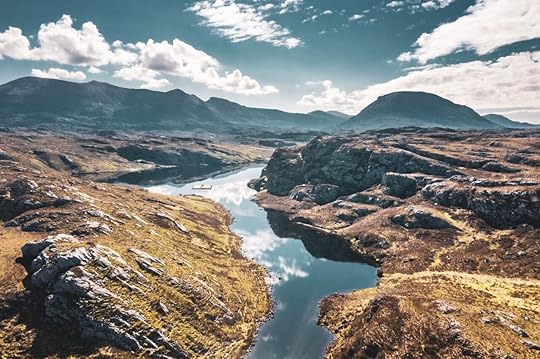
Photo: Airborne Lens/VisitScotland
Located in the far north west of Scotland, this region is home to some of the country’s most impressive mountain ranges and coastal landscapes. An outdoor playground of almost 800 square miles, the Geopark is home to diverse geological and geomorphological finds — some of the oldest and most important in Europe. The coast of white sand beaches is ideal for camping and there’s a huge range of walks and hikes for all abilities. We also recommend renting a bike and taking time to explore this stunning landscape slowly on two wheels.
9. Shetland, UNESCO Global Geopark
Photo: Kenny Lam/VisitScotland
The subarctic archipelago of Shetland is located between Norway and mainland Scotland. Shetland UNESCO Global Geopark groups over 100 islands and is deemed by UNESCO as “more geologically diverse than any similar sized area in Europe.” But it’s not just its dramatic natural beauty that draws people to explore this unique landscape. This region of Scotland has fascinating history and culture, too. You can learn about the customs and traditions of Shetland, and how people lived, and still do, in this remote part of the world by taking time to talk with locals and visit various museums and exhibitions.
10. Heart of Neolithic Orkney, UNESCO World Heritage Site
Photo: Kenny Lam/VisitScotland
Orkney has some of the most fascinating archeological sites in the United Kingdom. Dating back to the Neolithic period some 5,000 years ago, monuments remain at four key sites near Stromness on Orkney’s mainland. These extraordinary examples of Neolithic architecture include Skara Brae, a domestic settlement, Maeshowe, a chambered tomb, The Stones of Stenness, standing stones, and The Ring of Brodgar (another impressive standing stone circle). These remarkable displays of sophisticated early civilization are breathtaking and can be visited year-round with a guide or independently. We recommend experiencing the stone circles at various times of the day as differing light (and weather) can drastically change your experience.
11. St Kilda World, Heritage Site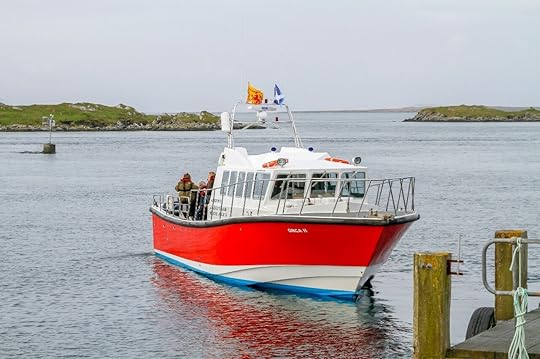
Photo: Paul Tomkins/VisitScotland
The otherworldly St Kilda archipelago, in the Outer Hebrides of Scotland, dramatically juts out of the North Atlantic Ocean. Composed of five islands — Hirta, Dùn, Soay, Boreray, Levenish — and a few smaller inlets, St Kilda is home to the largest colony of Atlantic puffins on the British Isles. The remote volcanic landscape is a crucial habitat to nearly one million seabirds, which nest on some of the tallest cliffs in the UK. The islands have been uninhabited since 1930 but the extraordinary biodiversity of this World Heritage Site can be visited on a day trip. Boats leave Leverburgh harbor on the isle of Harris daily. 
Best places to see in Highlands
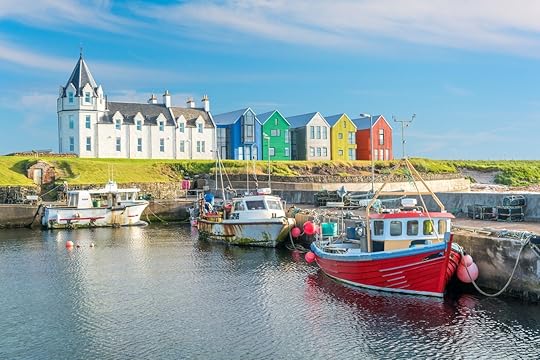
The well-trodden western coast of the northern Scottish Highlands is a common road trip destination for visitors to the United Kingdom. But to escape the crowds flocking to the Isle of Skye, head to the east and north, where far fewer visitors venture and you can actually enjoy a bit of peace and quiet at the top of Britain. These five spots along the North Coast 500 route will make for an unforgettable road trip, that can be easily extended even further west should you want to continue the journey. You may even have the winding roads to yourself along the way, except for the occasional flock of sheep crossing the road.
The fairytale castle of Dunrobin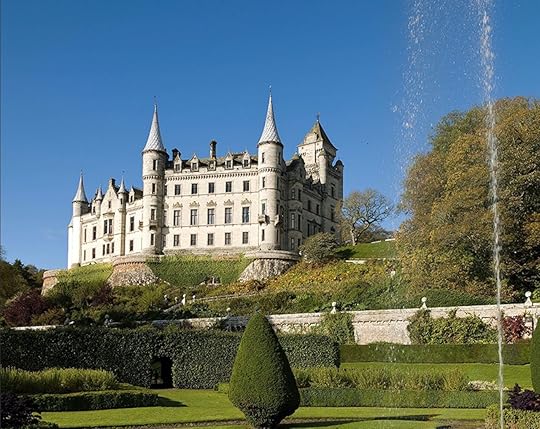
Photo: Dunrobin Castle
The 189 rooms of Dunrobin Castle make it the largest in the Northern Highlands. The oldest parts of the buildings date back to the 13th century, and in its history, the castle has served multiple purposes, including its original role as a summer home for William, Earl of Sutherland, and more modern purposes that include as a boys’ school and a naval hospital during World War I. The tall and narrow spires, built in the style of the French châteaus, will make you feel like you’re visiting a place of childhood fairytales. This is furthered as you walk through the lavishly decorated rooms and into the castle gardens that were inspired by the ones in Versailles. The entire setting is historic, but its most significant wares are housed in the on-site Victorian Museum, including its collection of Pictish symbol stones and mounted animals. The room is set in the style of the early 1900s, so not only will you learn about Scottish history, you’ll actually feel it. Admission is 12 British pounds, and the castle is open from April through October.
Where: Golspie KW10 6SF, Golspie, UK
Spooky ruins by the sea
Photo: Benny Marty/Shutterstock
After Dunrobin Castle, it’s time to spend some time outdoors. Drive up north for a different kind of castle visit, the ruins of Sinclair Girnigoe. Although there’s no shortage of castle ruins in the Highlands, Sinclair Girnigoe is significant for its remote location on a cliff’s edge. Leave your car in the nearby field and walk the narrow path to the coast, where you can admire the rugged rocks and majestic waves as you wander through the remains. Far less is known about the history of this castle than of Dunrobin other than that two castles have occupied the area and they were attacked by cannon fire around the year 1680, so read the plaques posted around the site and add in a bit of personal speculation. This is a free attraction, though you’ll have to walk about half a mile from the car park. Sinclair Girnigoe doesn’t have the museum or the tea room of Dunrobin, though, so bring your own water bottle and anything else you’ll need for the walk in a backpack. The ruins are open to visitors from May through September.
Where: Wick KW1 4QT, UK
Seabirds and flat whites in John O’ Groats
Photo: travellight/Shutterstock
Most travelers going to the Northern Highlands stop in John O’ Groats, as it’s popular for being the northernmost point of the mainland. In truth, you can get further north about 11 miles to the west in Dunnet Head. Nevertheless, John O’ Groats is worth a visit, as it is the departing point for ferries to the Orkney Islands as well as shorter tours, including a popular wildlife cruise. In about an hour and a half, you’ll see seabirds and, with a bit of luck, maybe even dolphins and whales. In the port, you’ll also find what may be the only joint serving flat whites and buddha bowls in the Northern Highlands, as Scottish food tends to be quite heavy. Stacks Coffee House and Bistro claims to be the northernmost mainland restaurant in the UK and could be your only shot at locally sourced vegetarian dishes anywhere in the area. Even if you don’t want to eat, its coffee is a solid way to warm up for your ferry ride.
Where: Unit 3, Craft Centre, John O Groats, Wick, Highland, UK
The northernmost point of the Scottish mainland
Photo: rphstock/Shutterstock
Admiring the views from the cliffs of Dunnet Head will make you feel like you’re standing on the edge of the world. The views are especially impressive in the evening, just as the sun starts to set. Catch the last rays of the setting sun on Dunnet Beach, just a 15-minute drive away. A narrow path through the sand dunes will lead you to a beautiful secluded beach, and unlike more well-known sunrise spots like Bali’s Mount Batur, you’ll be able to enjoy the setting in quiet solitude. While you’re there, check out the iconic white lighthouse and take a photo looking back toward the south — Edinburgh and Glasgow are way down there, nearly six hours away.
Mountain views in Tongue
Photo: Tomas Wolfschlager/Shutterstock
The small village of Tongue, an hour and a half west of Dunnet Head, makes for a great final stop in the Highlands. It’s home to the Kyle of Tongue, a shallow sea loch that has been listed as one of the 40 National Scenic Areas of Scotland. The mountainous backdrop of Ben Loyal and Ben Hope contrasts the seaside views you’ve had throughout the rest of the road trip. For a bird’s-eye view of the scenery, climb up to Castle Varrich ruins. The 1.75-mile hike climbs 364 feet and takes about an hour. 
February 28, 2022
The forgotten code that helps road trippers understand US interstate highways

Highways: We pretty much all have to use them. In the era of being able to rely on the GPS on your phone, it’s pretty simple to figure out where you need to go. Things were different before people always had a map in their pocket, though. And it turns out that the numbers and names of highways hold the key to understanding where you’re going. The Youtube account CGP Grey recently explained some of the simple (and not so simple) rules of the road created by the Interstate Highway System.
The first set of rules to know are those that guide the interstate majors. Interstate majors follow an east-to-west, north-to-south system. All major interstates that run east to the west end in zero, and the numbers are listed depending on how far north or south it is. For example, the I-90 most northern east-to-west interstate is Seattle to Boston. In contrast, the most southern east-to-west interstate, I-10, runs from Jacksonville, Florida, to Santa Monica, California.
East-to-west interstates listed from north to south:
Seattle to Boston: I-90San Francisco to Teaneck, New Jersey: I-80Cove Fort, Utah, to Baltimore: I-70Barstow, California, to Wilmington, North Carolina: I-40Little Rock, Arkansas, to Fort Worth, Texas: I-30Florence, South Carolina, to Kent, Texas: I-20Jacksonville, Florida, to Santa Monica, California: I-10.Looking at that list, you might notice that I-50 and I-60 don’t exist. There were already highways older than the interstate system like Route 50 and Route 66, there’s Route 66, so the code skips I-50 and I-60 to avoid confusion.
Similarly, the north-to-south interstates all end in the number five. The I-5 goes from San Diego to Blaine, Washington, and is the farthest west north-to-south interstate, whereas I-95 from Houlton, Maine, to Miami is the farthest east north-to-south interstate is I-95.
North-to-south interstates listed from west to east.
San Diego to Blaine, Washington: I-5San Diego to Sweet Grass, Montana: I-15Las Cruces, New Mexico, to Buffalo, Wyoming: I-25Houston, Texas, to Dallas, Texas: I-45Sault Ste. Marie, Michigan, to Hialeah, Florida: I-75Petersburg, Virginia, to Montgomery, Alabama: I-85Houlton, Maine, to Miami: I-95Contrary to the name, interstate highways like the I-45 can connect within a state and not necessarily between multiple states (in which case it’s an intrastate highway). There are also many rules explaining interstate mediums and interstate minors, with some exceptions.
Memorize these rules for your next road trip to the country’s best roadside attractions, and the next time your phone dies, these tricks and trips could help get to your destination without stopping for a charger.
Art by Maria Prymachenko destroyed

On February 28, 2022, the local history museum in Ivankiv, a town about 50 miles northwest of the Ukrainian capital of Kyiv, was burned down by Russian forces. The museum, which opened in 1981 and was recently renovated, is said to have housed more than two dozen works of art by Maria Prymachenko.
As a result of 🇷🇺 invasion, about 25 works by outstanding 🇺🇦 artist Mariia Pryimachenko were burned. The paintings were stored in Ivankiv Museum, Kyiv region. She created world-famous masterpieces. Her special gift and talent captivated Pablo Picasso.
🖼️“Two-headed chicken, 1977” pic.twitter.com/dfAyfkn1k9
— MFA of Ukraine 🇺🇦 (@MFA_Ukraine) February 28, 2022
Maria Prymachenko was a highly celebrated, self-taught folk artist born in the village of Bolotnya near Ivankiv in eastern Ukraine in 1909. She was famous for her joyful and vivid drawings and paintings.
Art by Maria Prymachenko often represents animals (sometimes behaving like humans, playing musical instruments and wearing hats); fantastical beasts such as horses with wings and two-headed chickens; scenes of rural life in Ukraine such as harvests, family meals, and individuals at work; and vibrant flowers (sometimes with human characteristics).
Despite coming from a peasant family and having spent most of her life in Bolotnya, Maria Prymachenko is perhaps the most well-known Ukrainian artist in the world. According to Wall Street International Magazine, Maria Prymachenko won a golden medal at the Paris World Fair in 1937. It is also said that upon seeing her work in Paris, Pablo Picasso said “I bow down before the artistic miracle of this brilliant Ukrainian.”
So acclaimed was her work that her art appeared on Ukrainian stamps in the 1970s.
The 25 works of art by Maria Prymachenko housed at the Ivankiv museum are suspected to have burned. The National Museum of Ukrainian Folk Decorative Art in Kyiv, home to hundreds of her works (including paintings, ceramics, and embroideries), expressed its sadness and anger at the news in a Facebook post:
“This is painful news for all admirers of the genius of the Ukrainian people — Maria Prymachenko, who left us a legacy of priceless works, from which we still draw inspiration and wisdom. The destruction of the Ukrainian cultural heritage by the Russian occupiers is a crime that will never be justified and forgiven!”
In 2018, Christie’s auctioned 15 postcard-sized works of art by Maria Prymachenko from 1940 for more than $25,000.
In 2021, a mural representing Maria Prymachenko was painted by Sasha Korban in the town Ivankiv to celebrate the artist. 
What it’s like to travel to Abu Dhabi right now

We hope you love the stays we recommend! Just so you know, Matador may collect a small commission from the links on this page if you decide to book a stay. See our full Advertiser Disclosure here.
International travel has been difficult for many Americans over the past two years. That’s especially true for places that require a long flight to get there. But now, as pandemic restrictions ease across the world, places are opening up, from cruises to Saudi Arabia to a fully open Ireland.
The United Arab Emirates and all its luxuries aren’t as unrestricted as some countries, but the people and their government are eagerly welcoming visitors. People from the United States aren’t required to quarantine upon arrival thanks to a rigorous testing policy, and on a recent visit, I could eat at bustling restaurants, shop in souks with fully open storefronts, and explore the architecture and culture that make the capital city of Abu Dhabi so magical.
For anyone who has had Abu Dhabi on their list, the winter, spring, and the fall are ideal times to visit to avoid the hot and sticky summer. Here’s what you need to know before scheduling a trip.
What to know before going to Abu Dhabi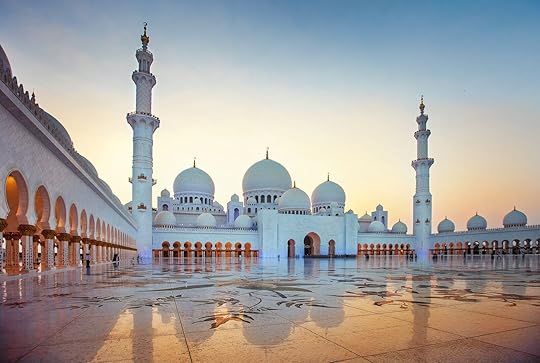
Photo: Elena Przhevalskaia/Shutterstock
Travelers are required to register with ICA Smart Services at least 48 hours before traveling to Abu Dhabi. Doing so sends over your vaccination status and is the first bit of paperwork to fill out. You’ll also need to take a PCR test no more than 48 hours before your flight.
Then you’ll need to download the Al Hosn app, which is the government app for contact tracing, and acts as the de facto entrance pass to anything public throughout the UAE. It’s recommended to download the app and register prior to arrival.
Businesses and attractions ask to check the app and its QR code proving vaccination status before entrance to just about anywhere, from hotels to restaurants to attractions. A glitch kept Al Hosn from working for me or the other American members of my party, but we could move freely with our vaccination card and proof of a recent test (in my case, a text confirmation from the airport testing center) in hand.
Getting to Abu Dhabi
Photo: Tupungato/Shutterstock
I flew a direct flight on Etihad Airways from New York City to Abu Dhabi. The airline’s app made it easy to keep track of what I need, and it’s also where I entered my testing information to get into the country. It’s a long flight — over 12 hours there and 14 hours back. If you can spring for it, business class in Etihad offers lay-down seats, a large TV, meals that taste far better than what an airplane meal typically tastes like, and a sommelier-chosen wine, beer, and spirits menu.
Note that masks are mandatory for the entire flight unless actively eating or drinking.
On arrival, every passenger is required to take another PCR test that’s provided at the airport. It’s far faster, and wildly more efficient, than any testing I’ve done in the United States. It took less than 45 minutes to deplane, get tested, and be out of the airport on my way to the Park Hyatt Abu Dhabi. I received a text message with my negative results even before my room service arrived.
The US is a Green List country, meaning that travelers need another PCR test on the sixth day after arriving in the country. People from non-Green List countries need to take a test on the fourth and eighth day.
Anyone who tests positive for COVID-19 in Abu Dhabi must quarantine in a designated hotel for 10 days, or until they have two negative PCR tests at least 24 hours apart.
What it’s like in Abu Dhabi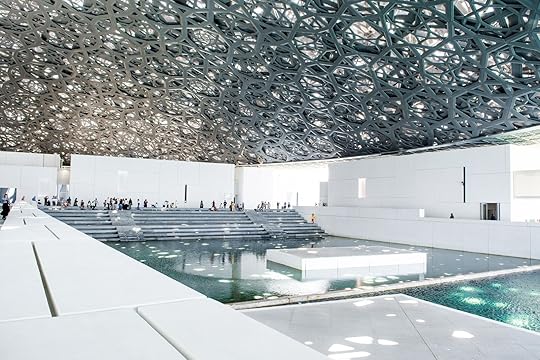
Photo: Myroslava Bozhko/Shutterstock
Masks are required both indoors and outdoors in Abu Dhabi, and everyone I saw complied with the rules. Restaurant owners I spoke with noted that visitors were trickling back into the country, though it’s far from the peak number of tourists before the pandemic.
Major attractions weren’t exactly crowd-free, but there was plenty of space to move around. My local guides all had a working Al Hosn app and showed their green light to breeze past the people checking vaccination status at the doors of each restaurant, shop, and cultural landmarks like the Louvre Abu Dhabi and Sheikh Zayed Grand Mosque. I never ended up getting the app to work, but it sufficed when needing to show the text message from my negative test I received at the airport along with my vaccination card (I used my paper copy, but others in my group showed a screenshot of theirs).
The extra steps to do anything felt like a lot coming from the US, where pandemic restrictions have largely lifted in my home state of Colorado. That said, the UAE has had a successful pandemic response — especially when compared to the US — so the rules, and people’s adherence to them, are clearly working. Mask mandates and frequent testing are simply the way to see the world these days.
I didn’t once have any worries that I would have an issue getting back to the US thanks to these rules and the UAE’s high vaccination rate: 100 percent of residents have their first shot, with nearly 96 percent having their second shot, according to government statistics.
Getting back to the US from Abu Dhabi
Photo: Parradii Kaewpenssri/Shutterstock
Another major benefit of the UAE’s extensive testing program is that it’s easy to get the test needed to reenter the US. Mine was scheduled through the front desk at the Anantara Eastern Mangroves hotel the morning of my day before my Etihad flight home, and the results were emailed to me before dinner. (Rather than the time-restricted 48 hours for getting into the country, “one day before” was enough for the test to return to the US.)
Abu Dhabi International Airport has a US pre-clearance facility, so you don’t have to do a customs check at the airport when you land. The process was faster than most of my experiences getting through customs at US airports, as is often the case with these pre-clearance zones. It’s a relief, to put it lightly, to not have to wait in a customs line after a 14 hour flight.
People looking to return to international travel can feel safe with a choice to Abu Dhabi, whether they make the city their only destination or use it as a home-base to explore other parts of the UAE. Yes, it’s a long flight. But after two years of sticking closer to home and jumping through an endless number of hoops to travel internationally, the UAE’s organization makes travel in the era of the pandemic feel easy. 
Airbnb is offering free temporary housing to 100,000 Ukrainian refugees

The Russian invasion of Ukraine has led to hundreds of thousands of refugees. To help, Airbnb.org, the company’s independent non-profit, is offering free, short-term accommodations for up to 100,000 refugees fleeing Ukraine for neighboring countries, according to a news release.
These stays are funded partially by Airbnb’s for-profit sector, donors to the Airbnb.org Refugee Fund, and hosts opening up their homes. The company has reached out to government officials in Poland, Germany, Hungary, and Romania for support in welcoming refugees with hopes of assisting with longer-term stays.
400,000 Ukrainians have fled to European countries like Poland, Hungary, Moldova, Slovakia and Romania as of February 26, a spokesman for the United Nations refugee agency told The Washington Post.
“We need help to meet this goal. The greatest need we have is for more people who can offer their homes in nearby countries, including Poland, Germany, Hungary and Romania. If you can host a refugee, go here: http://airbnb.org/get-involved,” Airbnb co-founder and CEO Brian Chesky tweeted.
1. Airbnb and https://t.co/enqjlQB0rH are working with our Hosts to house up to 100,000 refugees fleeing from Ukraine, for free
— Brian Chesky 🇺🇦 (@bchesky) February 28, 2022
In August 2021, Airbnb announced it would offer housing to 20,000 refugees around the world. In mid February, it met that promise with an announcement that the company had provided housing to 21,300 Afghans and is now working to provide free temporary housing to another 20,000 refugees from Afghanistan, Africa, the Middle East, Central and South America, and other regions.
Couchsurfing, another hosting company, posted on its Instagram that it also plans to offer free access to its services.
View this post on InstagramA post shared by Couchsurfing (@couchsurfing)
Airbnb.org is working with local non-profits to coordinate stays for refugees regardless of nationality, race, ethnicity, or how they identify. The company suggests that anyone in need of immediate support get in contact with resources through the UN Refugee Agency. 
On the ground in Ukraine, one man’s documentation of the fight for an ‘entire way of life’
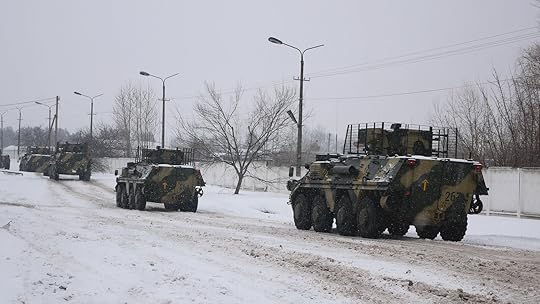
For many people in the United States, the tensions between Russia and Ukraine have been a far-off topic. Ukranians, however, have been grappling with it for decades. Now those tensions have turned into Russia’s invasion of a sovereign nation as Ukrainians fight to defend their borders against a much larger country and military force.
It has become all the more clear over the past week that this struggle doesn’t only impact Ukraine and the surrounding region. It has wider-reaching, global implications for democracy and the right of sovereignty and self-determination.
From schoolteachers and nurses forming civilian militias, to President Volodymyr Zelensky’s defiant “I need ammunition, not a ride” remark in response to a US offer for evacuation, Ukranians are ready for a fight. Ordinary citizens have taken up arms to defend their neighborhoods, launched fundraising campaigns to supply the Ukrainian military, and used social media to raise global awareness of the conflict.
Vladyslav Stadnyk, a Ukrainian living in Kyiv, is one person who has been at the forefront of these efforts. From sharing videos that illuminate the war’s historical underpinnings to organizing a campaign to procure body armor for troops, Stadnyk is the embodiment of Ukraine’s spirited resistance. We spoke to him about what’s going on in Ukraine right now, what he’s seeing, and how you can help.
This interview has been edited for length and clarity.
Matador Network: What is the situation like right now?Vladyslav Stadnyk: Right now I am located at a safe place in the mountains and don’t see any Russian troops. Although blasts and sirens are being heard all over the country, and people with kids and pets are running to metro stations several times a day to find shelter.
How are you getting information and communicating with loved ones?We’re getting all of the information only from official sources via social media and websites. With loved ones we communicate via phone and internet like usual.
What’s the mood like?At the moment more than anything we feel anger! Anger and willingness to fight for our country.
How would you respond to those who believe it’s not the responsibility of the US and other Western powers to defend Ukraine?In 1994, Ukraine willingly gave up one of the largest nuclear arsenals in the world under an agreement that the US and the UK will defend Ukraine if that time comes. Well, that time has come!
The fight in Ukraine is not only the fight for our country. It is the fight for freedom of the entire world, and it is our joint responsibility to defend it.
There’s been a tendency to view this conflict through a political lens. Can you explain why what’s happening in Ukraine is a human issue, rather than a political issue?
It is not about politics. It is not about a specific people or parties. It is about people’s right to be choosing their own destiny and defending their way of life.
How can people in the US and around the world help Ukraine?Everyone in the US and around the world can put pressure on their governments to give real support to Ukraine. We need the US and NATO to protect our sky. And also cut Russia from SWIFT. Every letter and call to a local politician can help make that happen.
Where can people go for accurate, reliable information on what’s happening?I urge everyone to be reading only official Ukrainian government sources on social media and their websites.
Is there anything else you think an American audience should know about the conflict?Ukrainians are fighting not only for our country but for the entire way of life that is common for our nations. And we will defend it!
How do people feel about Ukraine barring adult men from leaving the country, as they may be required to serve in the armed forces?We have to do what we have to do to defend our country.
12 things you absolutely must know before you try ice climbing

for some winter adventurers, there’s nothing more exciting than snowshoeing or hiking through a snow-covered canyon to arrive at a gorgeous frozen waterfall.
But for some adventurers, there is one thing more exciting: climbing those frozen waterfalls with just a pair of spiked shoes and two ice axes.
You don’t have to be a rock climber to go ice climbing, but you do have to know a few basic things about the sport before you strap on your crampons. If you’re a first-timer, you’ll want to go with a guide and instructor. While the sport isn’t hard to do, the fact that you’re climbing on ice in remote areas and cold weather carries risk, and it’s not something you can do without some basic knowledge.
But don’t let that intimidate you. As James Walter, alpine guide at Yamnuska Mountain Adventures says, you don’t need much experience at all to try ice climbing. “Don’t be nervous,” he says. “Just come expecting to have fun. If you can climb a ladder, that’s the entrance level for ice climbing. You can make it harder from there, but that’s the start.” Walter has been guiding for four years in and around Banff National Park, where he’s taught the basics of ice climbing to everyone from British Special Forces to parents with young children on vacation.
1. What is ice climbing?
Photo: Suzie Dundas
Not to be glib, but ice climbing is exactly what it sounds like: climbing up ice faces, similar to rock climbing. Most ice climbing is done on frozen waterfalls to ensure the ice is thick and safe enough to climb — you don’t want to try to climb a column formed by a gradual drip. Like rock climbing, there’s usually one person climbing while another person belays from below. Experienced ice climbers can also lead climb, drilling holes to place temporary bolts in the ice as they ascend. But if you’re new to the sport, you’ll want to let someone else (like a guide) set the top rope for you.
2. Is it harder than rock climbing?
The weight of the ice climbing axes can be taxing on your arms // Photo: Suzie Dundas
Yes and no, depending on your rock climbing strengths and weaknesses. Skilled rock climbers know to use their leg muscles to stand as much as possible while moving up a route, rather than using their arms to pull themselves up. If you’re already doing that, in some ways, ice climbing may be even easier, as the ice climbing crampons on your boots can grip onto the ice almost anywhere — you don’t need to search as hard for a foothold as you do with rock climbing.
On the flip side, if you’re used to using your legs, you may find ice climbing to be more taxing on your arms. Your ice climbing ax will probably weigh around 1.5 pounds, and you’ll need to draw it back, swing it forward to dig it into the ice, and pull it back out each time you want to move up. Beginner climbers may find that holding their weight with one ax while searching for a secure spot to drive in the other ax is more fatiguing than rock climbing, a sport where you can have two hands on the rock most of the time.
3. Do you need any climbing experience?
The hike to your ice climbing site may be the most challenging part of the trip for beginners // Photo: Suzie Dundas
Believe it or not, no. According to Walter of Yamnuska Mountain Adventures, just about anyone can get on an ice wall their first time out, even if they’ve never worn a harness in their life. He says that the biggest challenge he sees with new climbers isn’t their physical ability, but rather, the mental aspect of falling or rappelling down ice. As a guide, he’s trained not just to teach how to ice climb safely, but how to help climbers get over their fears and hesitations when it comes to trusting the rope and the ice.
Guides can do more than just teach you to swing an ax — they can help you feel comfortable on the ice and learn to trust the equipment (and yourself) enough to really embrace the challenge.
4. How do you gauge the climbs and ice?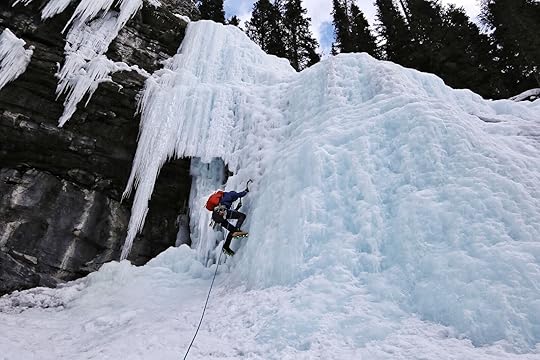
A W3 ice climbing wall has a slight incline and natural rest points // Photo: Suzie Dundas
Being able to gauge what ice is or isn’t safe to climb is an important skill and one of many reasons first-time ice climbers should go with a guide. In general, the bluer the ice, the better. As our ice climbing guide told us, blue indicates that the ice has some plasticity, or give, to it. That’s important, as you don’t want the ice to be brittle and break off every time you drive in your ax or crampon. Other factors to take into consideration include the thickness of the ice and the thickness of the place where it connects to the wall, especially if you’re climbing on pillars.
Ice climbing is graded on a one-to-seven scale. A W1 or W2 means you can mostly do it without tools, and most people define “ice climbing” as starting around W3 — a climb requiring tools and ropes, but with solid spots to stand and take breaks. W4s and W5s are more likely to have long, vertical sections with no natural spots to rest. W6s are very long, difficult, and technical, and W7s — well, forget about those, unless you’re an elite climber.
5. Is it safe?Ice climbing, especially under the direction of a certified guide, is an extremely safe activity in terms of accidents. However, while the potential for accidents is low, the consequences can be high. For most beginners, the biggest risk will probably be from tiny pieces of ice that could scratch your nose — but as Walter told us, “practice putting your head down right before you hit the ice with your ax,” to let your helmet take the hits.
Otherwise, very rare but potentially deadline risks include avalanches and ice falls, both of which can be mitigated by choosing the right section of ice in the right conditions at the right time and temperature. This is where a guide’s knowledge is invaluable. Many areas also have ice climbing forums where climbers can post updates (akin to trail reports). In Canada, climbers are encouraged to use Avalanche.ca to monitor and report conditions.
6. What shoes do you wear ice climbing?
Photo: Suzie Dundas
Don’t worry about having any special type of shoes if you’re a beginner ice climber going with a guide. Your guiding company will almost certainly have a pair of tall, stiff, and waterproof mountaineering boots for you to wear (so be sure to wear tall socks). They’re far more comfortable than climbing shoes and fit like roomy hiking boots. You’ll also need to wear metal crampons, which will snap to the bottom of your boot. While technically you just need the crampons for climbing, you’ll likely want to leave them on your feet all day to give you more stability when belaying or hiking in to the climbing site.
7. How do you secure to the ice?
Ice climbers use metal hand drills to dig deep holes into the snow for securing ropes and bolts // Photo: Suzie Dundas
Ice climbing does seem quite scary at first — after all, what happens if you’re attached to the ice and it breaks off? But depending on the climb, you may not be attached to the ice at all, as your climbing rope could be wrapped around a tree or bolted into fixed rock, as with rock climbing. If you are bolting into the ice, your guide will likely practice safety techniques to ensure redundancy, such as using two or three bolts in the ice (rather than one) or drilling holes to weave the rope through the ice multiple times.
8. Any first-time climbing tips?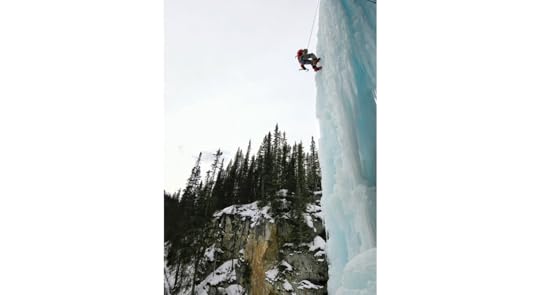
You may want to do a few test falls before beginning the full rappel after your climb // Photo: Suzie Dundas
Aside from keeping your head down to avoid tiny pieces of ice, there are a few tips you can try to keep in your head while climbing:
When you stop, try to have your feet wide and even to relax your muscles as possible.Try to climb up with your legs, rather than pulling yourself up with your arms. It may help to picture yourself as an inchworm climbing up the wall.Try to keep your feet level and at a 90-degree angle with the ice. Digging your toe straight-on into the ice will give you the maximum grip for the lowest physical effort.If you’ve never fallen while on belay before, try taking a few practice falls near the bottom. If you’re nervous, you can let the person belaying you know that you’d like them to keep the rope fairly tight (as opposed to having a lot of slack).You can stave off arm cramping by leaving your ax (securely) in the ice and shaking your arms out below you a few times mid-climb.9. Where can you go ice climbing?
Johnson Canyon, in Banff National Park // Photo: Suzie Dundas
It shouldn’t surprise you that you need to go somewhere with very cold weather to ice climb. But cold weather isn’t enough — it needs to be consistently cold to ensure the ice is stable; you don’t want to climb on ice that’s only going to be around for another week. It helps to go to areas away from the coast in the mountains, as they tend to have colder and dryer weather.
In the US, Ouray, Colorado, is a massively popular ice climbing destination, as are many of the frozen waterfalls throughout Wyoming and Montana. In the northeast, you’ll find good single-day beginner climbs around the White Mountains in New Hampshire. But if you’re able, consider going north to the Canadian Rockies, where Banff National Park and the nearby town of Canmore offer some of the world’s best ice-climbing.
“Climbing in general, we have such variety — really excellent sport and traditional climbing in the summertime,” says Walter of Alberta, Canada, where he lives. “The alpine climbing is phenomenal, with big, jagged peaks, and we have a long, consistent winter that makes for a really good ice climbing season. I like being able to change it up a lot. But t he thing that always blows me away about ice climbing is the places it takes you. Really awesome settings in water-sculpted canyons and gullies.”
Keep in mind that most ice climbing is on waterfalls, which means you may have a bit of a hike through a canyon or riverbed to reach the climbing site. You’ll want a large pack to carry all your gear and, more importantly, need to save enough energy after climbing to potentially hike your way back out at the end of the day.
10. Do you need ice climbing tools?
Ice climbing axes are one of your most important tools // Photo: Suzie Dundas
Yes — you cannot ice climb without a few specific pieces of gear. The most important (aside from your rope, of course) are your ice climbing axes, which have both a sharp spike on top and a curved grip to keep your hands from sliding off. You’ll also need the aforementioned ice climbing/mountaineering boots and crampons, as well as a helmet. You should leave your helmet on even when you’re not climbing in case of icefalls or breaks from other climbers. As with any climbing, you’ll also need a well-fitting harness and a belay device.
Your guide will likely have all the technical gear you’ll need and will also carry more advanced equipment such as an ice drill, belaying devices, anchors, bolts, and more. Be sure to ask what’s included if you book a tour. If you’re not with a guiding company, you’ll need to have all your own gear.
11. What should you wear ice climbing?
You’ll want warm clothing, including a beanie, puffy jackets, and thick gloves // Photo: Suzie Dundas
While ice climbing, you’ll likely alternate between being hot and cold, which means you need to have various layers for a variety of temperatures. You’ll want a moisture-wicking base layer, mostly so the sweat on your skin doesn’t make you cold once you stop moving. It’s easy to get cold while you’re belaying or watching other climbers, so be sure to have a large puffy jacket (ideally two). You’ll want a waterproof outer jacket and pant (fitted ski pants work well), as well as a beanie you can fit under your helmet and at least one pair of gloves. It doesn’t matter if your gloves are bulky or have no grip as it’s the axes that hold you to the wall, not your hands.
You’ll also want sunglasses, as the ice can be highly reflective, and potentially other cold-weather accessories like a buff/neck roll or face mask. It’s better to carry too many layers than too few.
12. How the heck do I find people to ice climb with?Ice climbing is definitely a niche sport, but Walter of Yamnuska Mountain Adventures has some suggestions on how to find guides and climbing buddies. “Facebook groups have bene really good for bringing people together for all kinds of outdoor sports, so that’s a great place to go meet other community members. Alpine clubs can be a good resource, as well as guiding outfits in different areas. We’ll be able to get you out and teach you the basics safely.” 
More like thisHiking7 epic caves you can hike through in the US
A culinary guide to Montana winters

The winter snowscapes of Montana are magical. There’s a whole lot of outdoor fun to be had in Big Sky Country once the days shorten and the temperatures drop. But for those in the know, there are plenty of winter treasures to be found indoors as well — namely, in Montana’s restaurants, coffee shops, pubs, diners, and more.
Throughout the state, local small-batch distillers and brewers, bakers and patissiers, java-heads and five-star chefs are working hard to give visitors that first-class Montana culinary experience, even — or dare we say, especially — come winter. Whether you’re looking for an après spot to cap off a fine day on the slopes or are content to enjoy the views of snow-capped peaks from more modest elevations, let yourself warm up with Montana’s on-fire food and drink scene. Here’s where to go.
Après delights
Photo: Jed Sanford / The Jawbone, White Sulphur Springs
Après dining is a long-standing Montana tradition, though it’s changed a bit over the decades. Check out these spots after a day on the slopes.
The Jawbone | White Sulphur SpringsYou’ll find equal parts warmth and relaxation at The Jawbone. The upscale cocktail lounge doubles as a fine-dining eatery, offering hearty-yet-elevated dishes like Chilean sea bass and peppercorn-crusted filet mignon. Pair your meal, whatever it may be, with a signature drink such as the Montana Huckleberry Mule — along with a day at nearby Showdown Montana, the state’s first ski area.
Dillon Tap House | DillonIf you’re a beer enthusiast, this cozy taphouse is for you. You’ll find some of Montana’s most-loved craft beers here, like Meadowlark Brewing’s Hobo Monkey IPA and the Latte Milk Stout from Neptune’s Brewery (in addition to highlights from around the Mountain West). Grab a seat here once you’re off the slopes at Maverick Mountain in Polaris, about 45 minutes away.
Nap’s Grill | HamiltonThis relaxed bar and grill is both a long-standing local favorite and the epitome of rustic-yet-refined Montana charm. Grab a Montana beef burger and a local craft beer or a Prohibition-era cocktail like “Bee’s Knees,” pairing Montana gin with lemon juice and honey. This one’s just 20 minutes from Lake Como Recreation Area in Darby and about an hour from Lost Trail Ski Area in Sula.
Bow & Marrow | HavreBow & Marrow is one for the history buffs. In the historic railroad town of Havre, this upscale steakhouse focuses on timeless culinary delights such as 16-ounce ribeyes and Alaskan king crab. You can also expect an inventive selection of shared plates — hello, blistered shishito peppers — and a nice list of Montana craft beers and signature cocktails. It sits about 45 minutes north of the Bear Paw Ski Bowl, a beloved community spot and nonprofit operation owned by Rocky Boy’s Chippewa-Cree tribe.
Fine dining
Photo: Donnie Sexton / Lucca’s, Helena
Montana restaurants of the “white tablecloth” variety have exploded in number in recent years. Get gussied up and scout out these splurge-worthy establishments.
Lucca’s | HelenaIf fine Italian fare plated to perfection is your idea of a must-have vacation meal, set your GPS to Lucca’s. With a menu that rotates seasonally but is always focused on Italian traditions with a fresh flair — including house-made pasta — you might as well be inside Montana’s Little Italy. And even though the bistro trends toward the casual, there are ways to take it to the nines, like ordering a reserve bottle from across the pond (e.g., France’s Chassagne-Montrachet).
The Union Grille | Fort BentonThe Union Grille is a farm-to-table Montana restaurant inside the beautifully restored Grand Union Hotel, sitting right on the banks of the Missouri River. Get cozy in the classic atmosphere as you enjoy seasonal dishes from pan-fried gnocchi and steak frites to tandoori-spiced rack of lamb. They have a selection of Montana’s best microbrews, too.
Chico Hot Springs | PrayCrave luxury? Welcome to Chico Hot Springs. This rustic-styled lodge and resort near the Yellowstone River — about 30 minutes north of the national park — pairs its James Beard-nommed fine-dining experience with access to natural hot springs. Produce is sourced from the onsite garden, and their renowned dishes (like trout almondine and beef Wellington) complement one of the most impressive wine lists in the region. Those in the know often say this is the spot that brought fine dining to Montana.
Note: Parties of 2–6 can have a private dining experience in the Tasting Room, sitting down to the chef’s tasting menu and premium wine pairings.
Pompey’s Grill | Three ForksIf sampling bison is on your Montana to-do list, put the warm and elegant Pompey’s Grill — located inside the Sacajawea Hotel — at the top of your itinerary. This hidden steakhouse gem constructed of reclaimed timber offers a variety of culinary options but caters first and foremost to the carnivores, what with its certified Angus steaks (fired and wood-smoked) and juicy bison short ribs.
Winter spirits
Photo: Jason O’Neil/Gulch Distillers, Helena
When the temperatures drop, Montanans drop in to their favorite distilleries, holes-in-the-wall, speakeasies, and bars to warm up from winter’s chill. Here’s where you’ll find them.
Gulch Distillers | HelenaFor those longing for a nostalgic sort of micro-distillery experience, Gulch Distillers delivers. This spot is one-of-a-kind in Montana’s capital city. Try the Flying Anvil Single Malt, a classic whiskey with prominent notes of honeysuckle, apricot, and nougat, or the Flintlock Bourbon Cask Spiced Rum, a dry, light-bodied rum with primary notes of banana and spice, finishing with cardamom. You can also nab cocktails, tastings, and back-of-house tours.
Willie’s Distillery | EnnisMontana moonshine is a Montana must. This rustic, wood-sided small-batch distillery sources fresh grains from local farmers. Along with Montana Honey Moonshine, you can warm up with winter spirits like Huckleberry Sweet Cream Liqueur, Montana Chokecherry Liqueur, or their Big Horn Bourbon. Find it on the banks of the Madison River, right on Main Street in Ennis.
Westslope Distillery | HamiltonWestslope provides a true small-town Montana experience. (Population of Hamilton? 4,700.) Their smooth Timber Cruiser Rye Whiskey is made with their Lost Trail Rye Vodka — aged nine months in No. 4 charred American oak barrels — and has a dark caramel color with smoky notes of toffee, cocoa, vanilla cake, and nutmeg. Beyond their mainstay bottles, they also offer mixology classes, themed nights, and a variety of cocktails in their library-esque tasting room.
Fifty One Below Speakeasy | ButteFor some undeniable fun, little beats this quirky Prohibition-inspired cocktail spot set within the Miner’s Hotel. The journey to the basement lounge is an experience in itself, involving a vintage rotary phone and a false wall with a secret door. Inside, bartenders serve up signature spirits like the famed Montana Huckleberry Mule and Miners Punch. As long as you can find your way in, you can’t go wrong.
Regional specialties
Photo: Wandering Albatross Photography / Park Avenue Bakery, Helena
In our opinion, Montana’s traditional cuisine doesn’t get enough attention — no Western state has a menu quite like it. From pasties to bear claws, here’s where to earn your local stripes.
Park Avenue Bakery | HelenaThis European-style bakery and cafe has mastered the apple bear claw and blueberry-pecan cinnamon roll. You know how steaming your bread is most bakers’ secret to perfect, crunchy crust and a soft, delectable crumb? For more than two decades, Park Avenue’s bakers have used an authentic Italian steam deck oven to get their masterpieces just right. And that attention to detail holds for their lunch fare — pizzas, soups, sandwiches — as well.
Big Sky Grocery | Moore (aka Eddie’s Corner)In Montana, visiting a local market for something special to eat is a legit winter pastime. And Big Sky Grocery — an Amish-owned market known by residents as “Eddie’s Corner” — is a true farm-to-market experience. You’ll find a rotating selection of delicious fresh baked goods, cheese curds, deli sandwiches on fresh-baked bread, small tokens for gifting, and — should the mood strike — their famous Wilcoxson’s milkshakes.
Mountie Moose Bakery | TownsendHidden within this quaint Montana cabin is a variety of winter treats, including chocolate peppermint hot cocoa bombs, maple-glazed long johns, and incredible strawberry and red velvet donuts. All this alongside tasty breakfast sandwiches, lunch items, and a house-brand espresso bar. They can also do full pies and cakes for travelers with a cause to celebrate.
Sherry’s Homestyle Bakery | PhillipsburgStart your day like a Montanan — with a beef pasty topped with country gravy. This small-town pastry shop has delicious fresh-baked goods like apple fritters and marshmallow-glazed donuts, too, with an espresso bar that boasts nearly 50 flavors. If you’re driving between Yellowstone and Glacier national parks, take a little detour off I-90 and let Sherry’s be your fuel-up. Every item on the menu pairs well with those sweet Montana winter views. 
Matador Network's Blog
- Matador Network's profile
- 6 followers



